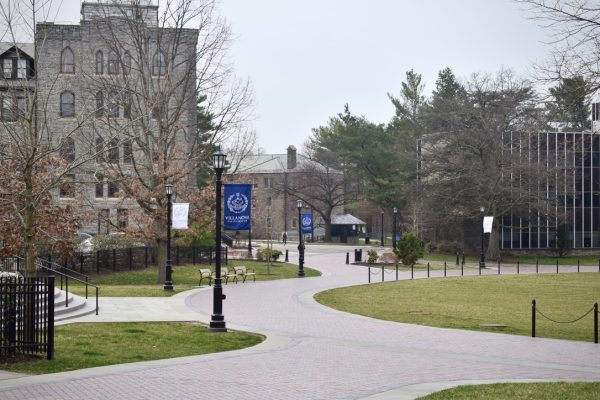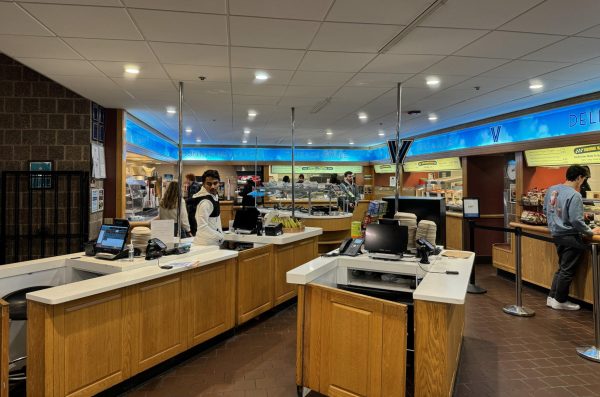It’s time for Villanova to put the Arts in Liberal Arts
April 30, 2015
Between classes, students flood main campus. The epicenter of campus, surrounded by the bookstore, the student center and the Pit, is marked by one of the college’s most famous symbols, “The Oreo.” Named after the popular Nabisco cookie, the black and white sculpture stands as a mascot and a meeting place. Although many Wildcats adore it, few actually know its name, “Awakening,” or the artist who created it, Jay Dugan. This ignorance is a result of the lack of fine arts education at the University.
“Villanova emphasizes and celebrates the liberal arts and sciences as foundational to all academic programs,” the University’s mission statement says.
“Liberal arts” is a term that has been interpreted in a number of ways. Often, the liberal arts include areas of languages, linguistics, literature, mathematics, arts (fine arts, music, performing arts), philosophy, psychology, religious studies, natural science and social science (economics, political science, sociology, history).
A subsection of the mission statement, part of the “enduring commitments” of the University, outlines how the University plans to “foster academic excellence.” It emphasizes an education that is diverse, liberal arts-based, interdisciplinary, searching for truth, respectful of all cultures and aimed at enriching the whole person.
Rev. Pres. Father Peter Donohue, O.S.A., is a known proponent of the arts. He earned a B.A., with a concentration in theatre and communication arts, from Villanova in 1975 and was ordained an Augustinian priest in 1979. He holds an M.A. in theatre from the Catholic University of America, a M. Div. from the Washington Theological Union, and a Ph.D. in theatre from the University of Illinois at Urbana-Champaign.
“Villanova prides itself as a liberal arts institution of learning, a place where humanity is examined with an open but critical mind,” Donohue said in his inaugural address as president. “Therefore, in our search for truth we can never renounce the liberal or ignore the arts.”
Villanova emphasizes the importance of the liberal arts, but there is no studio art program at the University. A student particularly interested in art would have to enroll in the art history program to study it, a program offered through the history department. But art history lacks the creative, hands-on component of other fine art programs. There are only two small art studio rooms located above the theater in Vasey Hall. With those rooms, Villanova offers a total of only 12 studio arts courses, three of which are music classes. Most students who enroll in these classes are doing so to fulfill a fine arts requirement.
“The Fine Arts requirement is met through courses that foster and develop an understanding and appreciation of artistic creativity,” the Enchiridion, the College of Liberal Arts and Sciences’ undergraduate academic handbook, says. “While some courses may focus on the creative processes that go into making a work of art, others may focus on analysis and interpretation of the products of that artistic creativity.”
The creative process of making works of art is the very essence of art, and is the most absent aspect of art on this campus. Hopefully, that will soon change.
“The Villanova studio art department is currently garnering interest about a minor in studio art,” Ashley Leamon, administrative assistant in the theatre and studio art department said in an email that was recently sent out to students.
Though the availability of a studio art minor would be a step in the right direction, it would be a small one. For years, Villanova’s graduate theatre program has thrived, and only a minor in theatre has been offered to undergraduates.
The performing arts have long been overlooked. Villanova has an office of music activities, but does not offer a music program. This is surprising considering the popularity of extracurricular organizations like the band, a cappella groups and the open-mic club.
Wildcats interested in the performing arts might have something to look forward to. Villanova University has been in the midst of its “For the Greater Great” campaign. The movement is seeking to raise $600 million. Some of the funds may be allocated to building new campus facilities along the south side of Lancaster Avenue. The proposed plan includes a performing arts center to support Villanova Theatre, student theatre, and related campus programs according to the university’s website.
So what’s a state-of-the-art performing arts center going to do for the prestige of the institution?
The arts enhance education in a number of ways. Art improves language, aids self-expression, and facilitates independence and collaboration, helps students understand abstractions, enhances test scores, improves attitudes and social skills, and involves both critical and creative thinking, according to the article, “Learning Through The Arts” by Dee Dickinson of Johns Hopkins University.
“It’s a handicap to not have some knowledge of visual language because it is used all the time,” Elisabeth Nickles, professor of fine arts at Villanova University said. “For younger people to live a full life, to live a rich life, that’s encompassing of all of human history, they have to look more at art and integrate it in education with history and science.”
Art, understanding art, literature, metaphor and creative expression: these are the things that make us human. We make art just for the sake of itself, to communicate cultural differences, emotions, and historic events, Nickles said.
Nickles also mentions art as an inexplicable facet of human nature, as inherent and mysterious as faith. At a Catholic University like Villanova, art certainly has a place.
“What sets us apart from other animals: art and faith, two really not-logical things,” Nickles says. “That makes us different, that we can empathize with a painting of a horse and know it’s about World War II.”
Art has value, and yet, it is not successful as an academic program. Students do not want to major in something that won’t get them a job.
“A lot of people really focus on their GPA,” Nickles said. “I think it is very hard to go into the arts as a profession. But as a role in educating people—just like literature in high school—to become a well-rounded person, art is important.”
Fostering the growth of the whole person is a tenant of the University’s mission statement. The institution also emphasizes the importance of diversity. It is possible that bringing fine arts to the campus might attract different kinds of students, thereby diversifying the student body.
According to Nickles, students who were not brought up with experience in the fine arts are often surprised by their creative abilities. They come to realize that art is very difficult, and isn’t such a frivolous thing. Often, they even find it interesting.
There is a thirst for more artistic creativity at Villanova University. The students are interested. The facilities can be adapted. The faculty is capable. The president is supportive.
“Let us be the artists who gather, shape and fashion our unique images of Veritas, Unitas and Caritas,” Donohue said. “Let us blow our breath into the life of Villanova.”







